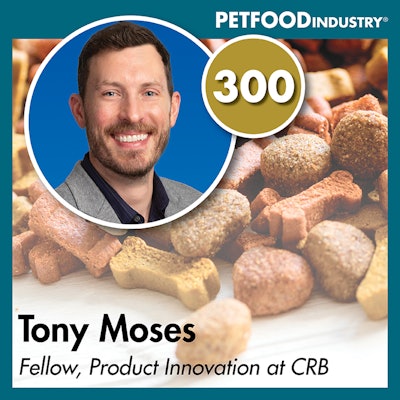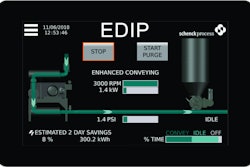
Fellow, Product Innovation at CRB Tony Moses and I did a deep dive on the plant-based protein trend in pet food. Where does it fit into larger current trends? What makes it a practical option for some pet food companies to consider? What are the current economic pitfalls to look out for if you're looking to expand your product line to include a plant-based formula? We have answers--tune in to hear them!
The below transcript is from Episode 23 of the Trending: Pet Food podcast, where I spoke with Fellow, Product Innovation at CRB Tony Moses about the growth of plant-based protein options in pet food forumlas. You can find the episode at www.PetfoodIndustry.com/trending-pet-food-podcast, on SoundCloud or on your favorite podcast platform. This episode originally aired on December 7, 2022.
Lindsay Beaton – Editor, Petfood Industry magazine and Host, Trending: Pet Food podcast
Hello, and welcome to Trending: Pet Food, the industry podcast where we cover all the latest hot topics and trends in pet food. I'm your host and editor of Petfood Industry magazine Lindsay Beaton, and I'm here today with Fellow, Product Innovation at CRB, Tony Moses. Hi, Tony and welcome!
Tony Moses – Fellow, Product Innovation, CRB
Hi, Lindsay. Great to be here.
Beaton: In case you've not met Tony, here's what you need to know. He brings more than 15 years of broad industry experience to his role at CRB. As a Fellow he drives innovation and assesses industry trends to help clients navigate the unique challenges of highly technical and novel projects. Prior to joining CRB, he leveraged his experience in the food ingredient, packaged foods and pharmaceutical markets working with companies ranging from Fortune 100 to pre-revenue. His drive to deliver safe, high-quality products to consumers in an efficient production environment has resulted in multiple product launches, equipment commissionings, four peer-reviewed articles and one patent. He also served as principal process engineer with ConAgra brands and senior research manager with Givaudan. Moses holds a doctorate in chemical engineering from the University of California – Santa Barbara, and a Bachelor of Science degree in chemical engineering from the University of Nebraska. He serves as a director on the board of the Aksarben chapter of the Institute of Food Technologists in Omaha, Nebraska, and is a member of the American Institute of Chemical Engineers.
CRB is a privately held company and a leading provider of sustainable engineering, architecture, construction and consulting solutions to the food and beverage and life sciences industries. Led by its innovative ONEsolution service, CRB provides successful integrated project delivery for clients demanding high-quality solutions on time and within budget. The company's nearly 1,800 employees provide world-class solutions that drive success and positive change for their clients, people and communities.
In short, Tony has all the knowledge needed to help me answer today's question: How can pet food manufacturers successfully add plant-based proteins into their product offerings?
A lot of what's going on right now is very relatable in terms of other trends in the industry, because it was something that became very big in the human space and is now growing in the pet space under the larger humanization umbrella and the desire for pet owners to feed their pets the way they feed themselves. What is the appeal of a flexitarian lifestyle to pet owners when it comes to their pets?
Moses: Yeah, Lindsay, I think you hit on it there. It's all about the humanization of our pet food. So we're starting to treat pets as equal members of our family, and some of that's being driven by demographic shifts: We're having fewer kids, or we're delaying kids, and so those pets are becoming our fur babies and we're becoming pet parents. So it's that broader humanization trend. And what we're seeing, and it was part of a report that we did on producers, is an emphasis on sustainability. So we think as people are interested in more of a sustainable lifestyle that's affecting their diet, with pet food being humanized that's spilling over into pets' diets, and the play that plant-based pet food has is a potentially lower carbon footprint. So protein coming from plants, rather than animals, is viewed to be more sustainable because of that perception that it's a lower carbon-based footprint.
Beaton: Before we dive into what the considerations should be for a manufacturer who might want to add plant-based proteins into their formulas and really get into this trend, do you think it's a trend that is for everyone? Have you seen some manufacturers jump into it perhaps before they're ready, just because it seems like such an overarching, prevailing trend? There are other ways to be sustainable besides introducing plant protein, but it's very popular on multiple avenues. It's popular from the sustainability perspective; it's also popular on the trend of alternative proteins, which is linked to sustainability but is also its own trend.
Moses: Yeah, it's a great question. I'd say there was a point in time, maybe two years ago, where plant-based gave you instant credentials as being sustainable. I think recently, consumers have really started to scrutinize that link between plant-based and sustainable, like you say, there's movement with regenerative agriculture. So showing that your agricultural practices put carbon, or at least don't release carbon from the soil, is another way that pet food manufacturers, consumers are looking for sustainable products out there. You're seeing people starting to measure their carbon emissions, whether that be primary, secondary or tertiary sources. So you're seeing a lot more rigor imposed on the industry on what really will be sustainable or not. Even some of the new SEC rules are impacting that, we think. So yes, there are likely some producers out there that jumped in going after that plant-based claim, and that link to sustainability, that it might have been maybe not the right long-term move for them, especially considering all the complexity that plant-based protein can introduce into operations when you're replacing it for animal-based ingredients.
Beaton: So let's say a company has decided that plant-based is the way to go: They want it for sustainability reasons, or they just want the offering because their consumers are asking for it, or they find it as a way to expand within the space. What are some of the considerations they really need to take a look at, at the beginning, before they can even launch this? What do they need to really sit down with and go, "Okay, this is something that's going to suit us, this is something we're prepared for?"
Moses: Formulating pet food is actually, I think, a lot more complex than human food. A lot of times that pet is eating the same food day-in, day-out and so it really needs to be nutritionally complete and balanced. And you'll see many manufacturers go after that claim. So that would be, I think, top of my list that I would consider before jumping into this market is the nutritional content of a plant-based food versus an animal-based food. And if you look at your traditional sources of plant-based protein used in the human world, these can be protein isolates, similar to what you might have in a performance drink, or the crumbles, something that you might find in the refrigerated aisle. Those tend to have very different nutritional profiles than the animal-based products.
And there's several things to consider there: The macronutrients, the protein might be the same, you might be able to get kind of an apples-for-apples for total protein content, but your fat and your sugars and starches are going to be different. In general, your plant-based protein sources tend to have minimal fat in them, so that's going to be a big difference from your animal-based protein sources. Same with sugars and starches, they tend not to have much of that, right, they tend to be protein isolates. So that's one thing I'd look at. And then I'd also look at the micronutrients, too, a lot of the animal-based sources tend to be pretty rich in vitamins and minerals. Think of the liver that often is a byproduct from the rendering industry; that's going to be really rich in micronutrients, and most of your plant-based sources don't tend to have those micronutrients. So I would look at my nutritional label profile. And then I'd probably want to think about what else do I have to add to my formula to make up for where I'm missing those macro- and micronutrients that I want to have in there for my claims.
Beaton: It sounds like when all is said and done, the composition is going to be pretty different in terms of the materials that you're using to accomplish the end goal. How does that affect the actual manufacturing process?
Moses: Yeah, that's a good call. So the material handling may be different, and then even some of your equipment and room design could be different. And I'll get to an example for that. But if you switch from animal-based sources to plant-based, a lot of the animal-based come in 50-pound frozen blocks that are ground and shredded, so you need freezer space. And then you need equipment to lift those big blocks and kind of break it up. If you switch over to a powder, so that may be soy isolate or concentrate, now you're handling either 50-pound bags of powder or you've got a big bulk bag on motor. So you could be talking about very different ways of adding the raw material. You could be talking about new equipment to that, adding new equipment to your process line or your manufacturing facility.
And then from a safety standpoint, you really need to consider the combustibility of those powders. Powders can present an explosion hazard. And if that's the case, then you really need to think about how you're handling those, making sure that you're preventing ignition sources from coming into contact with those powders and then your housekeeping might be different, too. One of the challenges that you have with powders — think about like a sack of flour in your kitchen. If you bump the sides a little bit you've got flour all over your kitchen and not just in that one little area. And so you need to think about housekeeping and how you clean and get that dust down from every nook and cranny. That would be the biggest impact.
If you're going to add additional macronutrients and micronutrients, for fat as a macronutrient if you're sticking with plant-based that tends to be a liquid form so you might be pumping things in from buckets. I would imagine most manufacturers want to avoid solid fats like palm and coconut oil, but even then that's an additional consideration is how to maybe melt that and pump that in. So it could be additional equipment. Fats tend to be a little more difficult to clean — I think we can all relate kind of in our kitchen, cleaning up a nice cheesy dish versus tomato sauce that's water based, right, easy to wipe out, typically, versus taking a lot of soap. And then if you're adding additional micronutrients, you might already be adding a powder blend to your product anyway to kind of add some additional vitamins and minerals. But you have to really think about, "Will I have more of those solids coming through the facility? And can I handle those in a safe way?"
Beaton: This is starting to sound like a pretty significant capital investment. Is it as big of a capital investment as it sounds? And if so, what level of company is prepared to do something like this?
Moses: It can be. Your other options for plant-based sources could be those crumbles; those might be a little bit easier, they'll likely be frozen or at least refrigerated, so those might be more compatible with the existing equipment. But yeah, I think there could be some significant capital changes there. So if I were looking to make that change, I would start with what raw materials are out there that are compatible with my existing line. If you have to add a bulk bag, a motor, to move things, that's not too bad. I would say most companies could probably handle that amount of capital. But if you have to start changing your HVAC, or you're gonna be working in an environment where there's a lot of dust, I would say only large companies or ones that are fully committed to these types of products would be able to handle that. It wouldn't just maybe be kind of a minor line extension, it'd have to be a major revenue source for that company.
Beaton: I guess my next question then is, is being a company that primarily or completely formulates plant-based, is their capital investment in terms of equipment and supplies much different from a company doing meat-based formulations? Or is it, if you have the equipment, you're good to go, the equipment is the same, it's just a matter of not having all the pieces to do both.
Moses: If I were a company considering that, I kind of start with a thought exercise of how far can I push my formula without having to do major reformulation or change my capital, and see if that moves the needle enough. A lot of pet food processing facilities have a mixing step; if you're just adding minor amounts of a new ingredient that might be something that you can do by hand, and that could be relatively little to no capital there. But if you start to make major changes, and you're moving significant amounts of new raw materials through the facility, that's when the cap ex can start to pile up.
Beaton: Since we're already kind of into it, I want to keep going. Other than explosions and money, which are the downfall of many a good idea, what are some of the other top challenges or roadblocks that a company that has done the initial analysis, decided this is worth it, need to be prepared for that they might not have come up with in their initial analysis?
Moses: Pets are picky eaters, so there's a couple of things kind of wrapped up in that. One is changing the pet's food can be really difficult. A lot of times it causes issues with the pet's GI tract and they end up sick, and it's not something that a pet owner wants to deal with. It can be a really messy situation. So that would be something that I think a manufacturer would want to consider: Is there a way to transition their pet from their existing meat-based diet to a plant-based diet in a safe and kind of clean way? And that could look like introducing small amounts of the plant-based material in over time, or you might even do some studies and help owners of different breeds understand how to make that transition.
The other thing is that, you know, we hear from clients that dogs in particular have very strong preferences for types of food, fun stories of mixing different types of kibble and the dog will pick through and eat out the one type of kibble versus the other. So moving from an animal-based diet to a plant-based diet is going to impact the taste and the texture, potentially, of those products. So that might be something else that a manufacturer has to consider. They're going to add flavorings or texturizers to their product line to help bridge that gap and make it more attractive to the animal. We're seeing a lot of movement in the raw pet food area, there's been some great growth in that. And some of the thinking that I've heard behind that is animals prefer the taste of raw meat, again, especially dogs, to cooked. And so moving over to plant-based is a step even further from that raw, animal-based taste and experience. I think that would be something else that producers would want to consider and help pet owners with that transition.
Beaton: Expanding into a space that is a subset of a larger space is always some kind of investment and always involves some kind of risk. But there are a lot of destabilizing economic forces at work right now that could make something like this even more of a risk than usual. What are some of the economic factors that a company currently looking to introduce a plant-based option into their product line — maybe they're going to release in the first quarter of 2023 or the second quarter of 2023 — what are some of those things that they're probably grappling with right now, and how can they effectively move through that if they really want to get their product out on the market?
Moses: For this, the two big things that come to mind are supply chain stability and inflation. Supply chains are interesting everywhere, right? Like any industry, the shorter the supply chain for this, the better. Every port and cross-country trip that you can avoid reduces your risk of your supply chain being disrupted. I think the unique component for plant-based protein right now is the industry is undergoing some significant change. We've all seen the headlines for some of the refrigerated plant-based meat manufacturers: Planterra, Beyond Meat, they're struggling.
I'd say the other side of that discussion is the frozen-based value-add players like ConAgra, Nestlé, Kellogg seem to be very bullish on this industry. So right now we're at an inflection point where we're seeing different producers having different success stories. If I were vetting a supply chain, they would want to make sure not that it was short, but that it was stable as well. It's not a producer that's pivoting, maybe looking for something to fill an existing gap, I'd want to make sure that they were committed to being in this market, and therefore the long haul.
I think inflation is a really interesting story in the plant-based world right now. We mentioned that there is a little bit of slowing growth for plant-based meats right now. So that, you would think, would be good for inflation. Demand is letting up a little bit, hopefully that means there's less price pressure. The one thing I'd consider in the pet food space is that a lot of these materials used for plant-based proteins are also used in the human supply chain. The animal-based are, but that's typically not their primary focus. A lot of it are byproducts from the rendering process that are human grade, but just not in fashion. They're not desirable, typically, for humans to eat. So that would be one area, if I were a pet food producer, that I'd look at to just see, do I have other materials that are also in the human food supply chain? What are the dynamics around that? Do I expect that to offset what slowing growth is doing for price pressures?
Beaton: If there's somebody who's at the very beginning of this journey, and we haven't scared them away, what is something that you think they need to be prepared for when they begin considering adding plant-based formulations to their profile? Where should they really start their journey?
Moses: Using animal-based protein versus plant-based protein, making that change, is very complex because of the impact on formula and the nutritional completeness of the product. So I would start by having the discussion that, if I just replaced some of my animal-based protein with plant-based, would I like that product, would I like the way it looked, it tasted, could I make that in my existing facilities? And would that have the right appeal to a consumer? Could I say "made with plant-based protein, six grams," a claim like that? Would that be appeal enough? Would that move the needle enough? And if it wouldn't, then you might have to start making some of the difficult decisions about investing capital, significant changes in the formulation, and then you can see what benefits that brings as well as the costs in terms of formula complexity, production or operational complexity, and then capital costs. So I'd start with trying to move the needle a little bit, seeing if that got what we needed. And then if that didn't then push the needle further and see if the benefits are worth the trade-offs there.
Beaton: How difficult do you think it is for companies to walk that line between there's this big trend, it's becoming popular, obviously pet owners in general are going for it (there's clearly a subset of pet owners going for the plant-based trend), versus what do my consumers want? Do you think it can be easy to get swept up in the larger trend and forget about the fact that it might not be your target audience unless you're looking to reach out into a new segment that perhaps you haven't reached before with your brand? Do you find that that happens? Or are people pretty solid in terms of resisting a trend if it doesn't suit what their particular audience is going for?
Moses: We normally have the opinion that trends come and go very rapidly in the food and beverage industry. And it seems like COVID-19 has accelerated our expectations for what can be delivered when. So usually, when I work with a client to plan a new facility, we talk about all the different ways that we can flex with low capital. So my response to that would be, it's really challenging, even for the best of us, to discern what is a trend that's here to stay and what isn't. And so we really should plan for facilities in mind that have the greatest degree of flexibility.
I think the sustainability trend will continue to see that for years to come. It's been one of those things like health and wellness that continues to be there year after year. But how we get to sustainability I think will change. It's a pretty new thing, especially within our food, so I think that manufacturers would be wise to consider plant-based as an option but look at a much more holistic picture than that. For example, within the facility they could look to minimize energy, go to zero-waste facilities. You've seen it in the beer industry a little bit where people are trying to use renewable energy and putting that on their package. So I would say plant-based is likely part of that, but I wouldn't put all my stakes on any one solution within the sustainability realm. I think it needs to be a broader approach.
Beaton: And just to wrap things up, I want to know what success looks like. Among your clients who have gone down this sort of path, what do the successes have in common with each other? What are some of the commonalities that you see that would really make for a successful launch into this new type of space?
Moses: Success can look very different. There's two prototypes that I'd put out there. One is a company whose mission is built around sustainability and plant-based lifestyles. And they might go all in on this because it is core to what they do. And you'll even see companies out there doing this that are working to educate consumers on whether an animal-based diet is even needed for companion animals; they might even have a veterinarian on staff or consulting. And that's part of their marketing material. So I'd say that's one model: The all in, and you tend to see that being core to the personal values of people at the company as well as the mission of the company.
The other model that I'd say, plant-based or maybe sustainable products is almost a line extension of what they're doing so it's giving people options. And so you can see that companies might substitute; instead of meat chunks they might have plant-based chunks in one of their line. Consumers are happy with the quality of product, or the value of product, and are just looking for a little bit of variety in that. And we'll even see that in the animal-based products out there. People want different flavors and you're starting to see multipacks for consumers so their cat or dog doesn't have to eat salmon or chicken and rice day-in, day-out. That could be another successful model, is the line extension. In that case, I think you have to really consider, is it compatible with your existing manufacturing? If not, another option could be looking for a contract manufacturer, somebody who really knows how to make that product and deal with those risks, and maybe even they have the supply chain to source that material. You can treat them as a trusted partner and use their expertise to complement your existing offerings.
Beaton: Well, I really want to thank you for coming on and having this conversation, because with plant-based pet food growing in the space as an alternative protein, as a path down the sustainability track, I know that there are a lot of companies at least looking into it or considering the idea. And I feel like you've given them a lot to think about and a lot to consider. And maybe it will help them navigate the idea and see if it's something that is right for them, and to see if it's something that's even practical for them. Because it's not always the right thing to do, to jump on a trend if that's not part of your company's brand or what your audience wants. But if it is what they want, well, then you want to know how to succeed doing that. So thank you very much for being on today.
Moses: My pleasure. I love to talk pet food. It's a really, I think, challenging area to produce in, and so it's a lot of fun to think about some of the issues that are out there and how we can design production and manufacturing facilities to best suit that. It's been my pleasure.
Beaton: And speaking of what you can do for your clients, before we go let's do a little plug: Where can people find more information about you and CRB?
Moses: The best place would be our website, www.crbgroup.com. I have a profile up there, you can reach out to us, and we also have our Horizons Pet Food Report posted up there, where we surveyed over 300 producers in the space for trends happening in the area. So that is available for free download, as well as some other informational white papers on our website.
Beaton: Perfect. That is it for this episode of Trending: Pet Food. You can find us on www.PetfoodIndustry.com, SoundCloud or your favorite podcast platform. You can also follow us on Instagram @trendingpetfoodpodcast. And if you want to chat or have any feedback, I'd love to hear from you. Feel free to drop me an email: [email protected]. Once again, I'm Lindsay Beaton, your host and editor of Petfood Industry magazine, and we'll talk to you next time. Thanks for tuning in!

















